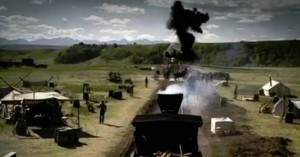 The building of the transcontinental railroad is such a good subject for a series, it’s a wonder something like “Hell on Wheels” (AMC, 10 p.m.) hasn’t happened before.
The building of the transcontinental railroad is such a good subject for a series, it’s a wonder something like “Hell on Wheels” (AMC, 10 p.m.) hasn’t happened before.
Just a few years after the Civil War’s end, the connection of the East and West coast was seen as a way to sew up the country after it was torn so violently North and South. Of course those wounds are still fresh and reignite as the crews move west from Council Bluffs, Iowa, California-bound.
Anson Mount stars as a former slave-owner who gets on board; Common is an African-American testing the post Emanicaption waters. Colm Meaney is convincing as the most ruthless railroad baron imaginable and Dominique McElliogott portrays the rare woman on camp who toughens up after an early tragedy at camp.
You can’t quite believe all the the history being retold on the series, though, as relations between the races seem based more on wishful thinking than brutal reality. Still, there are characters in the series that seem particularly well suited to the era.
Those comparing it to “Deadwood” are barking up the wrong tree; it’s more in the tradition of old Westerns, with the progress of the rail providing a natural narrative.
Joel Stillerman, Senior Vice President of Original Programming, Production, and Digital Content for AMC told critics at the TV Critics Association summer press tour “we have significantly high hopes for that show obviously because of the incredible sort of synergy between the western genre and our channel.”
It began with “Broken Trail,’ the four hour miniseries with Robert Duvall and Thomas Haden Church that earned a number of awards.
“To this day,” Stillerman says, it’s “the highest-rated piece of programming in AMC’s history.” (This was before “The Walking Dead’s huge premiere this fall; AMC of course is also home of “Mad Men,” “Breaking Bad” and the “The Killing” to mention just three of the greatest series of the past several years.
“We have a special relationship with the Western,” Sillerman says. “We have a very loyal fan base that we try and super serve whether it’s with episodes of ‘The Rifleman’ on Saturday morning or, you know, bigger Westerns like ‘The Unforgiven,’ ‘Pale Rider,’ anything with Clint really, you know, ‘Dances With Wolves’ and our primetime movies. So it was a no brainer for us to look for a next great western scripted series, but it was not a no brainer to find it. So it took us a while, but we think we’ve found it with ‘Hell on Wheels.’”
The name of the series, he says, “comes from what the actual tent city was called that they moved along the railroad as they built it, and this was a place that, you know, you could get any of your needs taken care of physical, spiritual, material, and any other need you had. You know, to say it was epic would be really an understatement, the undertaking of building this railroad. To say it wasn’t a pretty picture in terms of what life was like on “Hell on Wheels” would really not do it justice. They had a funny little slogan that, I guess, was designed to boost the real estate prices, which was ‘Hell on Wheels, population one less every day.’
“But it is certainly, from a storytelling point of view, one of the most inspirational and symbolic moments in our nation’s history and kind of set the tone for what happened in the country for the next hundred years,” he says. “We thought that was a pretty good place to jump off, you know, in terms of telling a scripted television series story.”
The immediate problem of “Hell on Wheels” is to distinguish itself from HBO’s “Deadwood,” which invariably comes up.
“If there are favorable comparisons to “Deadwood,” we’ll take them, you know. That’s terrific. I’d love that,” says Tony Gayton, an executive producer and co-creator. “But we really wanted this to be original and different and sort of look and feel different than any Western you’ve seen before.
Part of that comes from telling the story from the Eastern edge and moving West. “We’ve called this an ‘Eastern’ as opposed to a Western because it really was about bringing dragging this sort of almost urban ghetto across the prairie and industrializing this country,” Gayton says.
“We are really trying to make a realistic take on this,” producer John Shiban says. “We are constantly talking about what would it really look like, what would it really feel like, and it’s not a stylized version of a Western. We are really trying to make take the audience into that world as it was, and I think that sort of separates us from ‘Deadwood.'”
“in terms of the look, too, it’s like we have the iconic sort of Western images, the panoramas, the great wide shots. But then, when we are down in our city with the train and our steam driven saw mill and all of the prostitutes and the workers,” says Gayton. “It’s like, when we are in there, it’s that world, but we never lose sight of the fact that that great Western vista is always out there.”
Also, says his brother and co-creator Joe Gayton, “I think the other really big difference is the language in ‘Deadwood,’ it was very beautiful, but it was very stylized. I think there’s a much more sort of naturalistic way in the dialogue in this, and I think one of the really fun challenges of this show is that we we are servicing so many different accents, you know. You know, we’ve got a guy from the South. We’ve got Irish laborers out there. There’s we’ve got Norwegians and Germans you’ll see as the show develops. It really is like ‘Hell’s Kitchen’ in the West.”